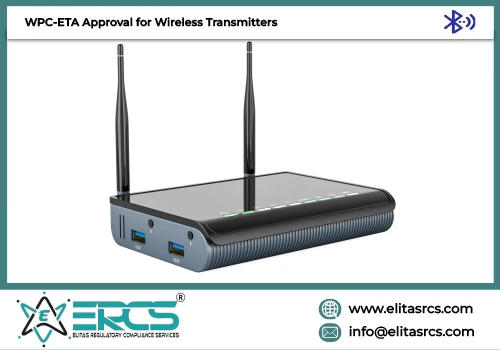WPC Approval (ETA) for
Wireless Transmitters

WIRELESS TRANSMITTERS
Radio waves and other forms of wireless communication allow for the transmission of data and signals, and it is these devices that are known as Transmitters. Many systems rely on transmitters, including those for radio and television transmission, wireless communication, remote control, and telemetry.
The term "transmitter" may refer to a variety of devices, both independent (such as a portable radio or a wireless microphone) and integrated (such as a mobile phone or a satellite communication system). Depending on the context and distance, they may also use a variety of wireless communication technologies including Bluetooth, Wi-Fi, or cellular networks.
A transmitter's primary purpose is to transform an incoming audio or video signal into an electromagnetic wave so that it may be broadcast through a radio or television signal, or through some other medium. Modulators are used to encode data onto a carrier wave, while amplifiers increase the signal intensity for transmission.
Depending on the intended use and applicable regulations, transmitters may function on a variety of frequencies. To prevent unwanted interference from other devices and radio services, the Federal Communications Commission (FCC) in the United States, for example, regulates the use of radio frequencies and sets restrictions on the power output and bandwidth of transmitters.
In general, transmitters are crucial to wireless communication systems because they enable data and signals to be delivered over great distances without the need of tethered cables or wires. To guarantee their secure and dependable functioning and prevent them from interfering with other devices and services, they must adhere to technical and regulatory requirements.
If your wireless charging device has received Wireless Power Consortium (WPC) certification, you may be certain that it will work with other devices in the market. Companies making wireless charging devices need WPC certification so that their products are compatible with the growing ecosystem of wireless chargers on the market.
To have your device certified by WPC, you must first submit it for testing to confirm it fulfils WPC's technical criteria, then pay a certification fee, and then get your item certified.
A manufacturer must take the following crucial measures to get WPC certification for their wireless charging device:
As a first step before submitting your item for WPC certification, you should verify that it satisfies all of WPC's technical standards. Aspects like power output, coil placement, and communication protocols are examples of such necessities.
When you've established that your product satisfies WPC's technical specifications, the next step is to send it to a lab that has been pre-approved by WPC for testing. Your device will be put through rigors testing in these facilities to verify it satisfies the technical specifications and interoperability criteria set out by WPC.
When your product has been evaluated and has been found to fulfil WPC's technical criteria, you may submit it for certification. This requires you to submit an application with details about your equipment, such as its technical characteristics and test results.
There is a price connected with WPC certification that varies with the kind of device being certified. Pay the certification fee. After submitting your device for certification, you will be required to pay the certification charge.
After submitting your device and paying the certification cost, you must wait for WPC to examine your application and test results before you can get approval. It will be certified by WPC if it satisfies their technical criteria and interoperability standards.
To review, you need to make sure your wireless charging equipment satisfies WPC's technical standards, submit it for certification, pay the certification cost, and wait for approval before it can be sold. Having your product certified by the WPC ensures customers that it will be compatible with all other WPC-certified products on the market.
Basic Requirement to get WPC (ETA) approval
Following requirement should be fulfilled by applicant –
Foreign Manufacturers –
Foreign Manufacturer (Applicant) has to appoint Authorized Indian Representative (AIR).
If Foreign Manufacture (applicant) has the Branch office/Liaison office in India then, they can become an AIR.
Domestic Manufacturer –
The domestic (Indian) Manufacturer can directly apply for ETA and import license without nomination of AIR.
Required Documents
For ETA Certificate –
- Copy of Company Registration /GST registration (For address Verification)
- ID and address proof of authorized person
- Radio Frequency (RF) Test report from any foreign laboratory that is ISO 17025 certified or an Indian laboratory that is NABL approved
- Authorization letter (If authorized person is other than CEO)
- Product technical details
For Import License –
- ETA Certificate
- Purchase order
- IEC Certificate
- Proforma Invoice
What is RF (Radio frequency) test report and how to get it?
RF (Radio Frequency) testing is a method of checking the frequency of radio transmissions to ensure that they are efficiently using the spectrum. In order to achieve maximum efficiency, it is essential to ensure that radio waves in the airspace do not conflict with one another.
Manufacturers/ Importer need to get the RF test report from the ILAC/NABL accredited lab for ETA approval to sell the product in India. If the multiple RF modules contains in the particular product, then the test report of all modules to uploaded to get ETA approval.
Process to get Equipment type approval (ETA) from WPC department:
- Checking EN standard and RF testing from AuthorizedLaboratory
- Documents Preparation
- Application Filing to WPC (Online portal generation)
- Submitting the requisite fee online to Govt.
- Application Scrutinization by WPC
- Grant of ETA Certificate by WPC

